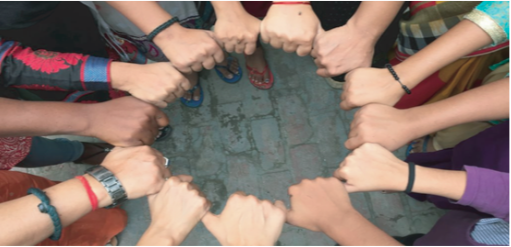I often wonder how decision making was organised in so many movements which Gandhi ji initiated or led, and am left more curious about it. I have heard of a few things from those who were connected with Vinobha ji, about his experiments with money, natural living, community living and governance. Now the question for me was, how would they have further evolved in their quest for finding non-violent, inclusive ways of governance in organisations and institutions, or even businesses.
Gandhi ji had the idea of trusteeship where the business owner is there to serve as a steward and serve the community through the businesses. I am trying to inculcate this trusteeship model at ‘Ahimsagram’, our business organisation, which has the vision of creating a world where individuals can reach their highest potential while working for the collective purpose, and while doing so, we want to set up regenerative businesses, so we can make the planet a safer and healthier place for all.
After actively engaging with different forms of political groups, movements, film production houses, businesses and NGO’s, I have often felt an unfulfilled desire to search for processes of governance where there is more autonomy, freedom, transparency, belonging and effectiveness.
In my past space of engagement, I was not finding a balance between individual empowerment and collective interdependence, and I wanted to raise my threshold in terms of being in more fulfilling and enriching forms of organisation. I saw that my own capacity was also limited at that time and there were not many people in those organisations who were willing to work on the processes themselves, to the extent I would have wanted to see them there at that time.
So, I took a break from community engagements and shifted to learning Nonviolent Communication (NVC), and then to look for self-managed organisation systems like Sociocracy and then towards Holacracy. Through the NVC lens, I began to look more into my interpersonal connections while being a bit more aware of the needs of all the people in a given situation, and how can we live in integration with the world around us. While going deeper into NVC, I also discovered Socioracy and Holacracy which are about forms of governance which try to work with shared authority and power in their own nuanced ways, where they integrate the collective and individual needs while keeping the purpose of the organisation as their vision. This also led me to creating ‘Ahimsagram’ as a learning and living space of people willing to organise themselves for a purpose, and one of the purpose itself being – to develop conscious and evolved ways of organising which allow us to reach our highest potential.
Holacracy, as a form of governance
We use Holacracy as our system of governance. According to me Holacracy has its roots in Ken Wilber’s work, where he proposed the idea of a ‘whole’, where everything is complete and every part is complete and two parts come together to create the third bigger part which is complete or whole. So in a way each person who is working in the company is an ‘whole’ while playimg his/her role. These wholes are interconnected through a web of processes which are directed by the constitution of Holacracy.
We have been working on self-management for four years and for the last two years we are practicing Holacracy. It has been a journey of celebrations and challenges, and working with diverse group of people, I am now seeing the real fruits of this experiment and can see how when we organise ourselves with purpose, transparency and distributed power, it brings autonomy, inspiration and freedom which leads to a self-managed organisation where each one is seen as a respectful player and enjoys the dignity of their work. Above all, it also builds more authentic and deeper personal connections outside the workspace. I often see miracles and magical moments where things run in perfect synchronicity, and I am wishing to have more such moments in our enterprise to happen at a more sustained level.
Control and command structure vs self-management
There can be two extreme ways of running a business on the two ends of the spectrum, one is a control and command structure like a Military, and the others is self-managed, and you can see where your organisation falls in the spectrum. We have been moving more and more towards, what I also call an eco-system organisation where we all play the role as it happens in a forest eco-system in our own place, and it also fits the larger picture and builds a mutually nourishing and ever growing world.
Often in a control and command structure the employee takes commands from others, is not trusted enough for their intent and even skills, making mistakes is punished, competition is encouraged, lack of transparency comes natural to the system as the one who does and one who plans are two different people, and then the thinking person knows more and may not even have the time or trust to share all the info to the person below them. No wonder, in such a system, people who do stuff have much less autonomy and do not use their intelligence or even experience and end up less inspired in their work. As a result the bosses have more in their plate and can be overwhelmed with nitty-gritties and are left with no time for ideation and strategising for innovation. Such system according to me will not be dynamic and people friendly.
In a self-managed organisation, there is high level of transparency, trust, collaboration, autonomy along with interdependence and feedback loops. All this creates inspired teams which can be more innovative and work towards the purpose of the organisation. I am seeing them each day in our four year experiment. People are willing to fight, say ‘no’ to requests and still be friends.
Self-management is not easy initially, when people who are not used to taking ownership, and take orders or demands in their past. It’s a challenge in the beginning, as people are coming from a society where so much is unsaid, and power is not shared. Submission and domination is the default mode for some people and it’s safer to not take charge or initiative, and so you do not get blamed for anything. Hence, there is very low accountability.
In self-management, we encourage another set of habits of taking ownership of roles and even mistakes. In case something does not work out, people can bring up the tensions arising out of their work and find solutions with support of other team members and even propose new polices or roles. Besides, the autonomy that is provided to each person, it gives them the space to take initiative, even if it ends up in mistakes. Here mistakes are seen as a way to evolve, and thus individuals can customise changes to establish new processes and polices unique to that organisation. Best part is that each one who is filling a role has a say in it and it`s not imposed top down. Even those on ‘top’ or in design roles need to reason it out with those who do the work. At the same time, some of the roles which are supposed to create the vision and allocation of resources are still with those who are investors or the initiators of the vision, but the way the work in organised and decisions taken are inclusive. Holacracy does not work with consensus but with integrated decision making and distributed authority, so even the owner cannot take away the autnonomy of a certain role without reasoning it, though they still will have the overall macro prioritisation or strategising in their role.
As a result there is really no vertical hierarchy, but a functional hierarchy, where there is a demarcation of roles and circles and they are interconnected. The information passes effectively in the whole eco-system of the organisation, and there is high level of transparency. In a mature holacratic organisation, everybody would be aware of the structure of the organisation, its polices, the reasons behind the actions taken, even the criteria for deciding the compensation, or how an employee can be asked to leave the organization and the reasoning for hiring someone.
An effective self-evolutionary process
I am often asked, “How can such an organisation be more effective, when someone does not do their part for whatever reason?”. When this happens, it causes a gap somewhere and another person gets impacted, but has access to processes where he/she can bring out the tensions. People could be reminded of their role and accountability. The person who experienced the tension can even propose a new policy, or change in policy, a new role or a new accountability in an existing role. For all this there are different meeting formats and processes so that anyone who experiences a tension, while playing their role has an equal opportunity to process their tension in consultation with others, and while integrating the needs of the different role fillers. The facilitator is not the leader but someone elected from the circle, and their role is to protect the space of each individual in the circle.
Self-management allows more autonomy and since there is space for feedback to be heard, there is a way for correcting tensions. It becomes a self-evolving process in organization-building and each person in a role, becomes the sensor of tensions that arise in the system, and is able to process them alone or with help of others.
There are many nuances to it, and it meets my vision of creating a world where while working for a vision each person’s voice also matters, and all can creatively contribute to the best of their potential with dignity and self respect, towards the purpose of the organisation. I am loving Holacracy for its integration of effectiveness, autnonomy and interdependence, which leads me to experience a work space which is life-enriching and integrates ahimsa in our daily life.
(In case anyone wants to know more about us or wants to do an immersion programme with us, they can write to us at ahimsagram@gmail.com)


 [/column]
[/column]